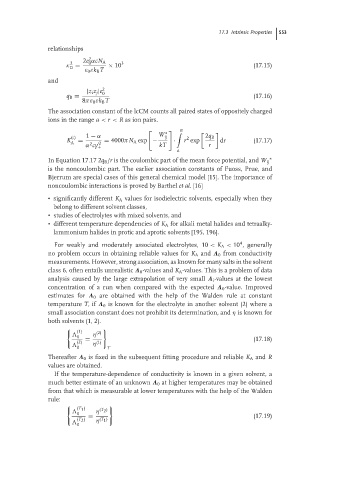Page 579 - Handbook of Battery Materials
P. 579
17.3 Intrinsic Properties 553
relationships
2
2 2e αcN A 3
0
κ = × 10 (17.15)
D
ε 0 εk B T
and
|z i z j |e 2 0
q B = (17.16)
8πε 0 εk B T
The association constant of the lcCM counts all paired states of oppositely charged
ions in the range a < r < R as ion pairs.
∗ R
(c) 1 − α W ij 2 2q B
K A = 2 = 4000πN A exp − · r exp dr (17.17)
2
α cy kT r
±
a
∗
In Equation 17.17 2q B /r is the coulombic part of the mean force potential, and W ij
is the noncoulombic part. The earlier association constants of Fuoss, Prue, and
Bjerrum are special cases of this general chemical model [15]. The importance of
noncoulombic interactions is proved by Barthel et al. [16]
• significantly different K A values for isodielectric solvents, especially when they
belong to different solvent classes,
• studies of electrolytes with mixed solvents, and
• different temperature dependencies of K A for alkali metal halides and tetraalky-
lammonium halides in protic and aprotic solvents [195, 196].
4
For weakly and moderately associated electrolytes, 10 < K A < 10 , generally
no problem occurs in obtaining reliable values for K A and Λ 0 from conductivity
measurements. However, strong association, as known for many salts in the solvent
class 6, often entails unrealistic Λ 0 -values and K A -values. This is a problem of data
analysis caused by the large extrapolation of very small Λ i -values at the lowest
concentration of a run when compared with the expected Λ 0 -value. Improved
estimates for Λ 0 are obtained with the help of the Walden rule at constant
temperature T,if Λ 0 is known for the electrolyte in another solvent (2) where a
small association constant does not prohibit its determination, and η is known for
both solvents (1, 2).
(1) (2)
η
0 (17.18)
(2) = (1)
η
0 T
Thereafter Λ 0 is fixed in the subsequent fitting procedure and reliable K A and R
values are obtained.
If the temperature-dependence of conductivity is known in a given solvent, a
much better estimate of an unknown Λ 0 at higher temperatures may be obtained
from that which is measurable at lower temperatures with the help of the Walden
rule:
(T 1 ) (T
η 2 )
0 = (17.19)
(T 2 ) η 1 )
(T
0

